Birdfinding.info ⇒ One of the commonest songbirds across much of its range, including most of the West Indies from Grand Bahama to Aruba and Tobago, and in the drier parts of northern Colombia and Venezuela. In southern Florida, most recent records have been in the Keys (especially Big Pine and Long Keys), with a few around the entrance to Everglades National Park.
Black-faced Grassquit
Melanospiza bicolor
West Indies and northern South America, in a wide variety of semiopen grassy and scrubby habitats, including urban gardens.
In the West Indies, resident throughout the Bahamas, Turks & Caicos, Jamaica, Hispaniola and its satellites, and Puerto Rico east through the Virgin Islands and south through the Lesser Antilles to Tobago.
Also in the southern Caribbean on the San Andrés Archipelago, the ABC Islands, and several of Venezuela’s Caribbean islands (Blanquilla, Los Hermanos, Tortuga, and Margarita).
In South America, occurs mainly in two areas: (1) coastal lowlands and thorn forests from Colombia’s Guajira Peninsula east through the Maracaibo Basin and Lara-Falcón to the Paria Peninsula; and (2) the Río Magdalena Valley of central Colombia and adjacent hills from around Bucaramanga south to southern Huila.
Generally absent from Cuba and its satellites, the Caymans, and Trinidad—but its status on Cuba’s northern keys is unclear. It has been regarded as resident on Cayos Tío Pepe and Paredón Grande, but a scattering of recent records suggests that is a somewhat regular vagrant, not a resident.
Historically an infrequent vagrant to southern Florida, with nine records before 2014, but there has been a dramatic increase in the Florida Keys and Everglades National Park, suggesting a possible range expansion in progress (or more effective observer coverage).
Identification
Male is distinctive, with olive upperparts and a black head and breast.
The extent and intensity of black coloration on the underparts vary widely, with some geographic tendencies. Those from Jamaica appear to have the least extensive black, with the lower breast and belly gray to whitish.
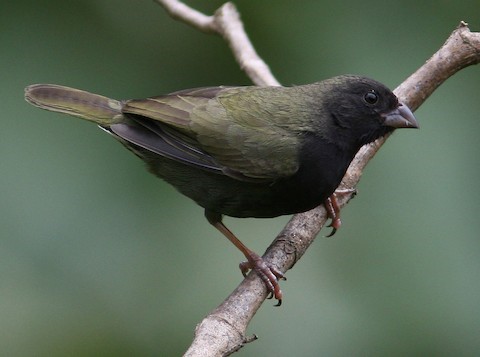
Black-faced Grassquit, male. (Caracas, Venezuela; March 13, 2009.) © Mikko Pyhälä
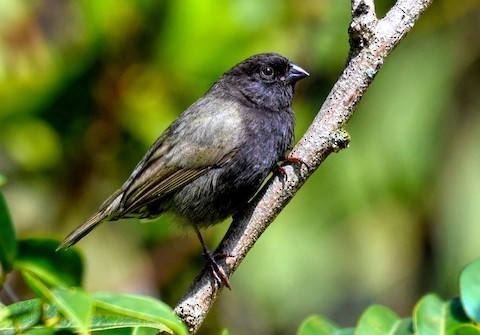
Black-faced Grassquit, male. (Stafford Creek, North Andros, Bahamas; March 12, 2018.) © Duncan Mullis

Black-faced Grassquit, male singing. (Coe Visitor Center, Everglades National Park, Florida; May 30, 2020.) © Bill Asteriades
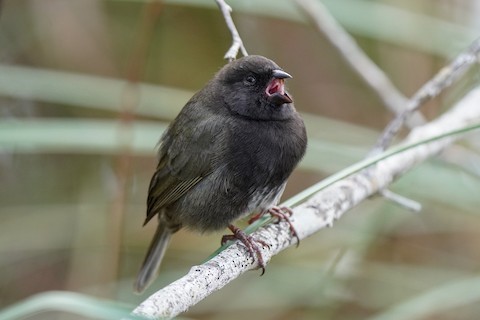
Black-faced Grassquit, male singing. (Blue Hole, Big Pine Key, Florida; February 13, 2021.) © Seth Yarkony
Bill color varies: usually all-black, but some have bills that are all-pale or intermediate or bicolored with a mostly blackish culmen and a mostly pinkish mandible. The Aruba population appears to have particularly large bills.
Leg color also varies: usually medium-brown or pinkish, but ranging from pale-pink and orange to dark-brown.

Black-faced Grassquit, male—note thick bill, typical of the Aruba population. (Masiduri, Aruba; October 9, 2016.) © Michael Tromp
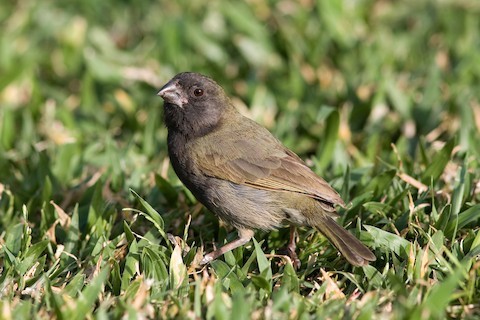
Black-faced Grassquit, male. (Bicuti Beach, Aruba; May 14, 2011.) © David Disher
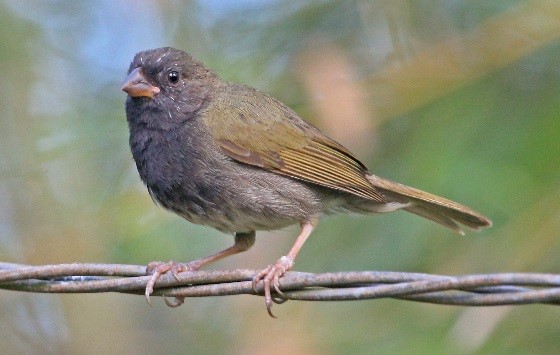
Black-faced Grassquit, male—note pale-pink legs and partly pale bill. (Rocklands Bird Sanctuary, Jamaica; February 15, 2014.) © Eric W. Greisen
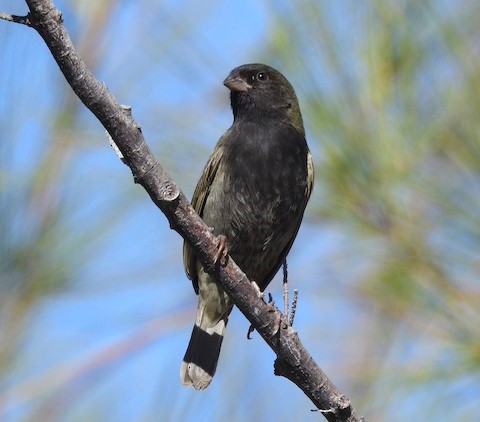
Black-faced Grassquit, male. (Discovery Beach, Grand Bahama; December 18, 2018.) © Erika Gates
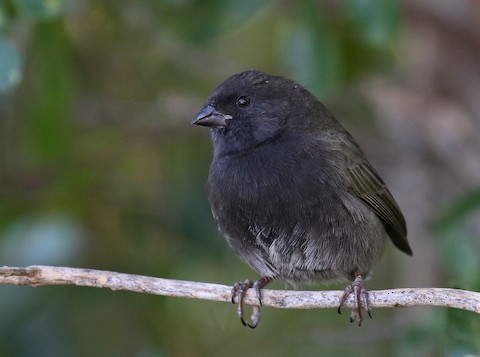
Black-faced Grassquit, male molting tail feathers. (Blue Hole, Big Pine Key, Florida; November 22, 2020.) © Matthew Grube
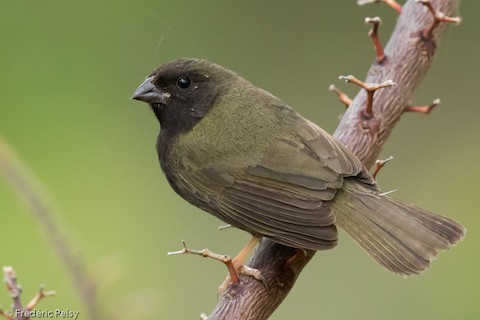
Black-faced Grassquit, male—note pale, orangish legs. (Fajardo, Puerto Rico; March 25, 2017.) © Frédéric Pelsy

Black-faced Grassquit, male at the dark end of the spectrum—note thick bill, typical of the Aruba popula. (Noord, Aruba; April 25, 2012.) © Sue & Gary Milks

Black-faced Grassquit, male. (Fort de France, Martinique; January 28, 2018.) © Noam Markus
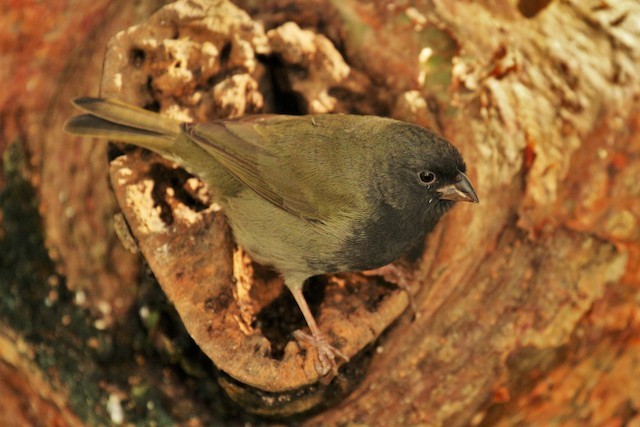
Black-faced Grassquit, male with bicolored bill and pale-pink legs. (Delphi Club, Abaco, Bahamas; December 10, 2015.) © Jason Estep
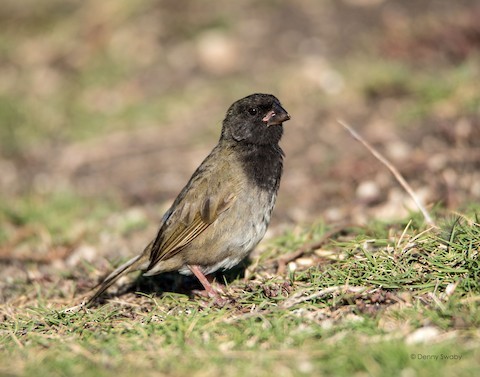
Black-faced Grassquit, male with black limited to head, neck, and chest. (Needhams Point, Barbados; February 16, 2017.) © Denny Swaby

Black-faced Grassquit, male. (Tolima, Colombia; December 9, 2020.) © David Monroy Rengifo

Black-faced Grassquit, male. (Frank Pond, St. John, U.S. Virgin Islands; January 16, 2011.) © Stephen Davies
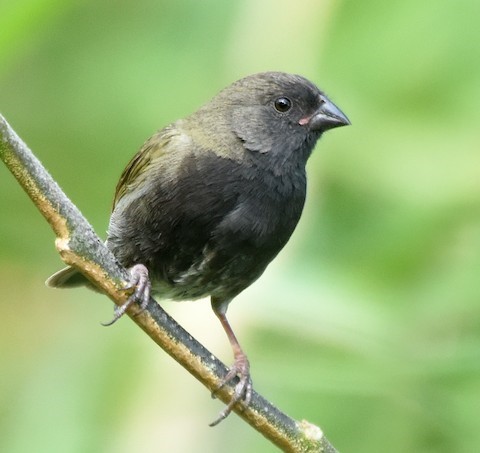
Black-faced Grassquit, male with extensively black underparts. (Bayfords, St. Kitts; March 6, 2018.) © Steven Mlodinow
Females are typically dull-olive above and paler and grayer below—but the tones of both upperparts and underparts can vary from greenish to grayish.
They potentially confused with other drab grassquits and seedeaters, particularly in South America where many species fit this general description. With close study, may be distinguished from most similar species by completely unmarked face (in which the eye is a small, bold dot) and olive tones in upperparts.

Black-faced Grassquit, female. (Jamanota, Aruba; February 28, 2020.) © Don Danko
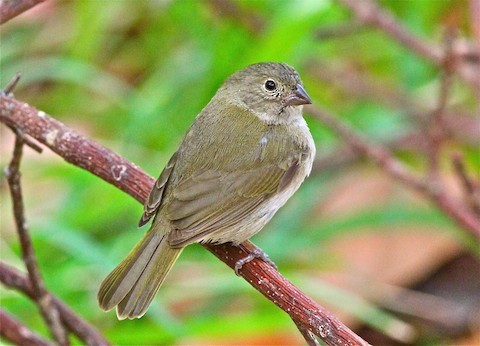
Black-faced Grassquit, female. (Bahia Honda State Park, Florida; February 27, 2015.) © Bill Hill

Black-faced Grassquit, female—note thick bill, typical of the Aruba population. (Tierra del Sol Gold Course, Aruba; February 2, 2014.) © Steven Mlodinow

Black-faced Grassquit, female. (La Parguera, Puerto Rico; March 8, 2017.) © John Anderson
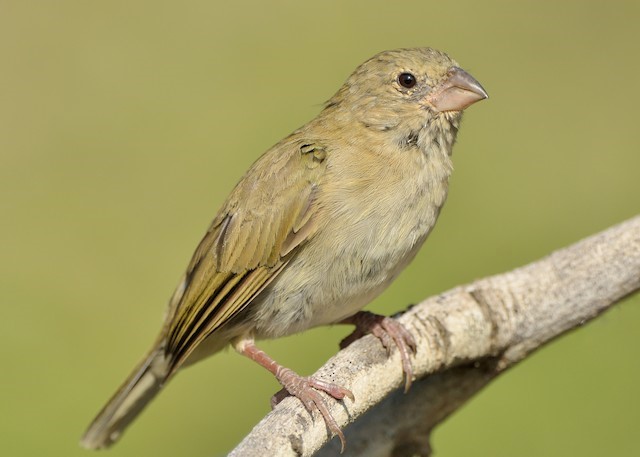
Black-faced Grassquit, female—note thick bill, typical of the Aruba population. (Bubali Bird Sanctuary, Aruba; December 19, 2018.) © Michiel Oversteegen

Black-faced Grassquit, female with pale bill and legs. (Barbary Beach, Freeport, Grand Bahama; January 6, 2017.) © Erika Gates

Black-faced Grassquit, female—an exceedingly drab, gray individual. (Bahama Palm Shores, Abaco, Bahamas; November 26, 2006.) © Brian Sullivan

Black-faced Grassquit, female. (Fajardo, Puerto Rico; March 21, 2017.) © Frédéric Pelsy

Black-faced Grassquit, female—note thick bill, typical of the Aruba population. (Bubali Bird Sanctuary, Aruba; July 26, 2017.) © Michael Tromp
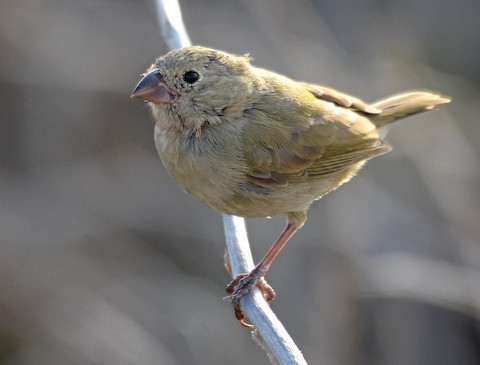
Black-faced Grassquit, female—note thick bill, typical of the Aruba population. (Tierra del Sol Golf Course, Aruba; April 12, 2017.) © Steven Mlodinow

Black-faced Grassquit, female. (Bubali Bird Sanctuary, Aruba; July 7, 2019.) © Michiel Oversteegen
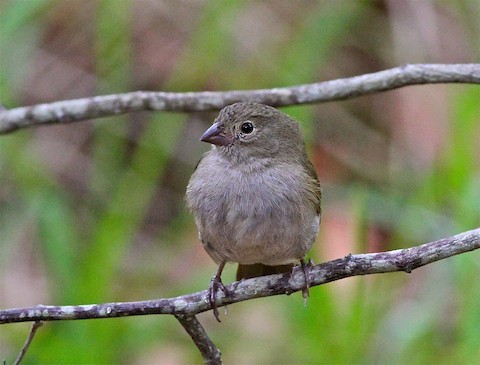
Black-faced Grassquit, female. (Bahia Honda State Park, Florida; February 27, 2015.) © Bill Hill

Black-faced Grassquit, female. (Long Key State Park, Florida; March 5, 2016.) © Steve Collins
Immatures strongly resemble females. The sexes become distinguishable gradually, as the males acquire blackish feathers around the face and chest.
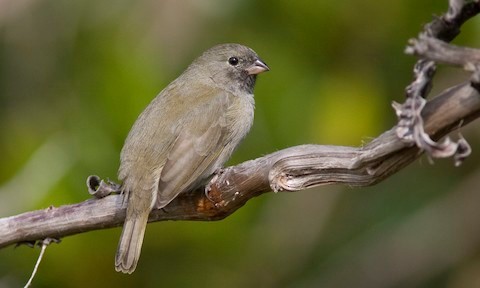
Black-faced Grassquit, likely immature male showing early stages of transition to adult plumage. (Crossing Rocks, Abaco, Bahamas; November 25, 2006.) © Brian Sullivan

Black-faced Grassquit, likely immature male showing early stages of transition to adult plumage. (Crossing Rocks, Abaco, Bahamas; November 25, 2006.) © Brian Sullivan
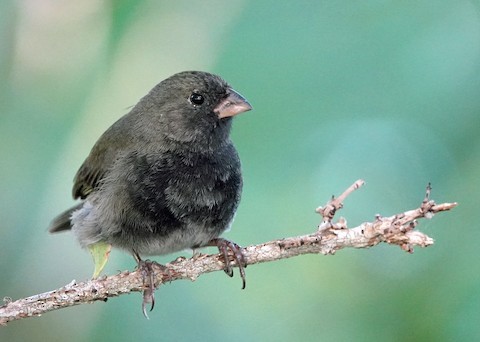
Black-faced Grassquit, male molting into adult plumage—note pale bill. (Powell Cay, Abaco, Bahamas; November 20, 2018.) © Jason Wilder

Black-faced Grassquit, likely immature male showing early stages of transition to adult plumage. (Casuarina Point, Abaco, Bahamas; December 7, 2015.) © Jason Estep
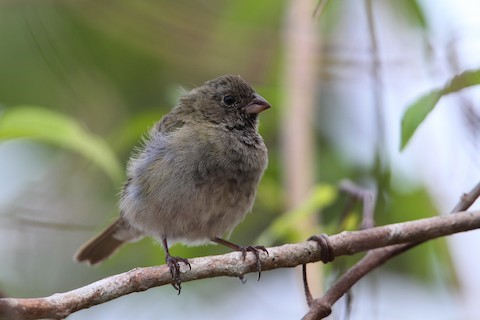
Black-faced Grassquit, likely immature male showing early stages of transition to adult plumage. (Old Citrus Farm, Abaco, Bahamas; January 7, 2013.) © Christoph Moning

Black-faced Grassquit, male molting into adult plumage. (St. Thomas, U.S. Virgin Islands; August 24, 2004.) © Kent Nickell
Cf. Sooty Grassquit. In northern South America, female Black-faced and Sooty Grassquits can be nearly indistinguishable. Female Sooty tends to appear essentially uniform above and below whereas female Black-faced tends to have somewhat paler, grayer underparts and slightly greener upperparts. However, variation within each species and due to observation conditions limits the potential value of such distinctions.
Cf. Dull-colored Grassquit. In northern South America, female Black-faced Grassquit is readily confused with both sexes of Dull-colored Grassquit. Dull-colored tends to appear browner above and buffier below, more like several Sporophila seedeaters.
Cf. Yellow-shouldered Grassquit. On Jamaica, female and immature Yellow-shouldered Grassquits are easily mistaken for male Black-faced Grassquit. The two species occur together frequently, so direct comparison is often possible. Across all plumages, Yellow-shouldered is brighter olive above, especially on the shoulders.
Cf. St. Lucia Black Finch. Male Black-faced Grassquits can sometimes be dark enough to appear all-black, especially in dim lighting, and can therefore be confused with male St. Lucia Black Finch. Both have pink legs and feet, but the black finch’s are usually a paler, brighter shade. Bill size and coloration are often conclusive: the grassquit has a smaller bill that is usually at least partly pale, whereas the male black finch’s bill is larger in all dimensions and all-dark.
Notes
Polytypic species consisting of eight recognized subspecies.
Based on mitochondrial DNA evidence of relatedness, a comprehensive taxonomic analysis of the Thraupidae published in 2014 places the Black-faced Grassquit in the genus Melanospiza along with the St. Lucia Black Finch.
References
Ascanio, D., G.A. Rodriguez, and R. Restall. 2017. Birds of Venezuela. Christopher Helm, London.
BirdLife International. 2018. Melanospiza bicolor. The IUCN Red List of Threatened Species 2018: e.T22723611A132167813. https://dx.doi.org/10.2305/IUCN.UK.2018-2.RLTS.T22723611A132167813.en. (Accessed April 27, 2021.)
Burns, K.J., A.J. Shultz, P.O. Title, N.A. Mason, F.K. Barker, J. Klicka, S.M. Lanyon, and I.J. Lovette. 2014. Phylogenetics and diversification of tanagers (Passeriformes: Thraupidae), the largest radiation of Neotropical songbirds. Molecular Phylogenetics and Evolution 75:41-77.
Burns, K.J., P. Unitt, and N.A. Mason. 2016. A genus-level classification of the family Thraupidae (Class Aves: Order Passeriformes). Zootaxa 4088:329-354.
eBird. 2021. eBird: An online database of bird distribution and abundance. Cornell Lab of Ornithology, Ithaca, N.Y. http://www.ebird.org. (Accessed April 27, 2021.)
Howell, S.N.G., I. Lewington and W. Russell. 2014. Rare Birds of North America. Princeton University Press, Princeton, N.J.
Kirwan, G.M., A. Levesque, M. Oberle, and C.J. Sharpe. 2019. Birds of the West Indies. Lynx Edicions, Barcelona.
Latta, S., C. Rimmer, A. Keith, J. Wiley, H. Raffaele, K. McFarland, and E. Fernandez. 2006. Birds of the Dominican Republic and Haiti. Princeton University Press.
McMullan, M., and T. Donegan. 2014, Field Guide to the Birds of Colombia (Second Edition). Fundación Proaves de Colombia, Bogotá.
Raffaele, H., J. Wiley, O. Garrido, A. Keith, and J. Raffaele. 1998. A Guide to the Birds of the West Indies. Princeton University Press, Princeton, N.J.
Ridgely, R.S., and G. Tudor. 1989. The Birds of South America, Volume I: The Oscine Passerines. University of Texas Press, Austin.
Xeno-Canto. 2021. Black-faced Grassquit – Tiaris bicolor. https://www.xeno-canto.org/species/Tiaris-bicolor. (Accessed April 27, 2021.)

